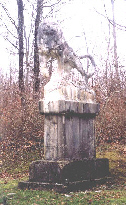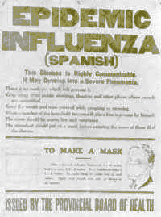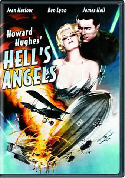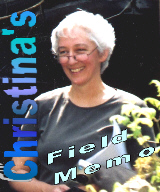
TRENCH REPORT: A New Year means a New Feature on the Trip-Wire. We have decided to give our Veteran of the Month a temporary leave of absence, so we can highlight the 90th anniveraries of some of the Great War's most memorable events. Also, we are starting to back up on contributions from our readers and I've concluded there is no reason to limit that feature to one per issue. This month Nelle Rote and Carol Clausen are our guest columnists on Page Two. Hope you enjoy the new and expanded features. . .Correspondent Joaquin Espinoza relays the news that Alfred Anderson, the "Last Survivor" of the 1914 Christmas Truce experienced the recent holiday in Alyth, Perthshire, Scotland. Mr. Anderson served in France with the 5th Battalion of the Black Watch and counts as his two most cherished possessions from that horror the brass embossed cigarette box he received from Queen Mary and the family Bible. . .Trip-Wire contributor Tony Langly says the Royal Army Museum in Brussels, Belgium has opened an exhibition of original Great War art entitled 'With Paintbrush and Rifle'. The exhibition shows
some 150 pieces of artwork produced by Belgian, French, British etc. (soldier) artists during the war. Many are by respected artists such as Alfred Bastien, Charles Fouqueray (French artist with the French fusliers marins in Flanders), Sherwood, Massonet, Ost, de Kat etc. (See poster at right). . .Reader Sebastian Wittler from Germany reports that at least three additional surviving members of the Kaiser's army have been identified besides Charles Kuentz who spoke at the Battle of the Marne ceremony. They were identified as: Arno Wagner, Hermann Dörnemann and Rudolf Wiederanders.

Memorable Event
|
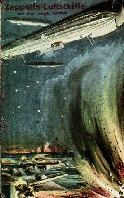
January 19, 1915
First Zeppelin Raid
On England
Click on Image for More Information
|
|
New at the Websites of the Great War Society and Our Friends
Click on Title to Access
|
|
At Great War Society Sites
At the WFA-USA
|

| This Month's
Special Feature
2004's Big
News Stories With a Great War Handle
|

The French Renault light tank and the British Mark series heavy tanks contained severe technical limitations. With maximum speeds of only 6 mph, these tanks were hardly able to keep up with the infantry when crossing a shell-holed battlefield. When separated from the infantry, the tanks were vulnerable to energy heavy weapons and could not communicate with supporting artillery. These technical limitations, as well as numerous mechanical problems, justifiably confined the World War I tank to an infantry support role.
LTC Kenneth A. Steadman of the US Combat Studies Institute
|
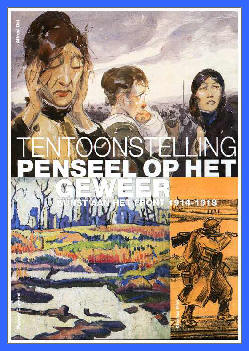

American Heritage Lays an Egg!
One magazine that has reliably provided fresh material on WWI--thanks in good part to contributors like Tom Fleming--has really disappointed with their latest issue. American Heritage's effort to provide the "definitive guide to the greatest books about our past" almost overlooks World War I completely. While providing thorough and first-rate reading lists for the Civil War and WWII, they selected a single work on the First World War. Compounding matters, William Leuchtenberg, the designated "selector" for the 1917 - 1941 period, chose the single most aggravating and dismal work on the American war effort, Over There by Stanford Professor David Kennedy. A review by Blogster Bill Brown captures the flaws of this work perfectly. (Read the Review) I guess a disclaimer is appropriate here: Mr. Brown's review does not necessarily reflect the views of the Great War Society nor its membership. [It does, however, reflect mine.]
Forrest Faight, 106 years old and a veteran of the 143rd Artillery of the AEF, died on Armistice Day. He reenlisted after the war and served another hitch with the new American Tanks Corps before returning home to Stockton, California. Afterwards, he worked as a career employee of the US Postal Service and then with his credit union. He enjoyed a daily scotch and water at 4pm and displaying his skills at trivia and memorization. He is survived by two daughters, three grandchilren and seven great-grandchildren.
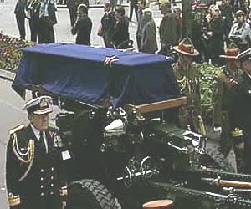 New Zealand's Unknown Warrior returned home in November after a trip begun at the New Zealand memorial site near Longueval, France.
(photo gallery)
New Zealand's Unknown Warrior returned home in November after a trip begun at the New Zealand memorial site near Longueval, France.
(photo gallery)
Finally, Canadian Pierre Berton, author of one of the definitive works on Vimy Ridge passed away at age 84.
GREAT WAR 2005 EVENT CALENDAR
|
WFA Pacific Coast Branch Spring Seminar
Victoria, British Columbia
March 11-13, 2005 (link)
|
WFA-USA East Coast Chapter Spring Seminar
Incl: Tour USS Olympia WWI Vet.
Philadelphia, Pa
March 19, 2005 (link)
|
Great War Society 14th National Seminar
America & the Great War, 1914-20
Furama Hotel, Los Angeles
April 22-24, 2005 (link)
|
WFA New England - New York Spring Seminar
FDR Presidential Library,
Hyde Park, NY
June 11, 2005 (link)
|
WFA-USA 16th Annual National Seminar
Virginia Military Museum
Newport News, Virgina
September 23-25, 2005 (link)
|
Send additions/corrections:
Email Response
|
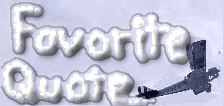 The notion that a soldier becomes hardier and bolder as war proceeds is mistaken. What he gains in the science and art of attacking his enemy he loses in strength of nerve. The only dam against this loss is a sense of honour so resolute that few attain to it. For this reason I consider that troops composed of boys of twenty under experienced leadership are the most formidable.
The notion that a soldier becomes hardier and bolder as war proceeds is mistaken. What he gains in the science and art of attacking his enemy he loses in strength of nerve. The only dam against this loss is a sense of honour so resolute that few attain to it. For this reason I consider that troops composed of boys of twenty under experienced leadership are the most formidable.
Ernst Juenger, Storm of Steel
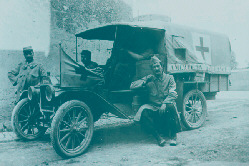
French Crew - US Ambulance
|
|
Page Two
|
 |
My Aunt's Last Christmas Letter from the Front
By Nelle Rote
|
[Editor's Comment: Nelle Rote of Pennsylvania enjoyed our special Christmas issue and thought our readers might like to read a holiday letter from her Aunt Helen Fairchild. Helen was an American nurse at Base Hospital 10, who died during her service in France. A bridge over the Susquehana River is named in her honor. (view photo)]
LeTreport, France
Saturday morning, December 29, 1917
Dearest Mother,
Just received at long, long last, a letter from you, the first in three weeks, so you can just imagine how awful glad I was to get it. Well, must tell you about Xmas. Unfortunately most of the things we had counted on having didn't come in time (that's what usually happens), and among the things that didn't come in time was the turkey for the Xmas dinner, but we substituted chicken for the nurses and the quarter master succeeded in getting goose for the patients, but we were rather disappointed not to have turkey for the patients, as the nurses, officers and men had given the money to buy the turkey, and we wanted them to have it. The Christmas bags that had been packed in Phila. didn't come, but we managed to have a nice Xmas. It was a fairly nice day and we had a party for the whole unit on Xmas eve.
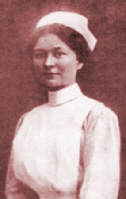
Helen Fairchild |
I did not go, but they said it was very nice and a choir of our nurses and some of the English men went all around the wards, and even came over to the offiers and nurses mess and sang Xmas carols Xmas eve. Then the nurses got up at 5:30 a.m. Xmas morn and made rounds in all the wards, singing Xmas songs. Of course, all the wards were decorated and we managed to find some little thing for each one of the patients. Then Xmas p.m. the officers gave a tea for the nurses and had real ice cream, which wasn't exactly like home, but tasted mighty good even at that.
But I was a lucky girl. I hadn't touched either of the boxes Edna sent me so I had them to enjoy Xmas day, and there were such nice things in them. A pair of the warmest slippers, pale blue, and a pair of white silk stockings and a little electric candle that will be so useful here. Then in the other box she had a perfect fruit cake and a big tin of home made candy and salted peanuts. In spite of the fact that I had kept those things for over two months, they were just as soft and fresh as could be.
Everybody raved about that candy. Part of the fruit cake I gave to Miss Dunlop and the rest I wrapped up in a dandy cloth and am going to keep it a while longer. Miss Dunlop and several of the girls each gave me very pretty handkerchiefs, Major Harte gave me fruit, and Wagner gave me perfume, so I had a very nice day.
The remarks you made about ____ sounds just like her, but I admire the rest for their attitude because what the Red Cross and the Y.M.C.A. are doing for us over here means so much to us. Really, it would be awful to get along without the things they send us and most of the pleasure that the troops get are the ones provided for them by the Y.M.C.A., and if you could see what these boys have to go through sometimes I think even she might be willing to do without a banquet to help, as we share to give them any comfort possible.
If the time ever comes when some of our own are sent over here I guess she would be glad to have them taken care of when they are wounded, and without the supplies sent by the Red Cross Society, we could not do half as much for them as we are...
With heaps of love and thanks,
from your own Helen
Click here to learn more about Nurse Helen Fairchild
|
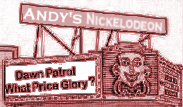 |
Howard Hughes's
Hell's Angels
By Andrew Melomet |
The Aviator starring Leonard DiCaprio as Howard Hughes and directed by Martin Scorsese has recently opened in movie theatres with great fanfare. Also, this past month Hell's Angels, Howard Hughes' World War I epic was quietly released on DVD by Universal Studios. Starring Jean Harlow, Ben Lyon and James Hall, Hell's Angels is a must for any WWI aviation fan. It's a shame this is a "bare bones" DVD release without any production notes or documentary. The Big Parade and Wings had been big hits, so Hughes decided to follow the established formula of romance combined with WWI combat action with his own production. He was just 22 years old when production started on Hell's Angels in October 1927. When Hell's Angels was finally released in May 1930, it had become the most expensive movie made to date. The production costs were $3.8 million to $4 million approximately $40 million in today's dollars.
One of the reasons production costs were so high was the introduction of talkies. Greta Nissen, the actress originally chosen as the love interest played a British socialite, but she had a thick accent. Hughes was forced to get rid of Nissen and all her footage. He replaced her with Jean Harlow. The two-color Technicolor sequence in Hell's Angels is the only color footage of the platinum blonde. The other reason the budget soared was the staged aerial combat sequences. Hughes hired dozens of WWI veteran pilots to perform stunts and authentic WWI aircraft as well as replicas were used. Hughes acquired and rebuilt 87 fighters and bombers. 37 of these were genuine wartime combat planes including Fokker D-VIIs, Avros, Snipes, Sopwith Camels, De Havillands, and S.E.5s. Thomas-Morse Scouts, Travel Air 2000s were among the planes substituting for war birds in some shots. Unable to obtain an authentic Gotha bomber, Hughes purchased a Sikorsky S-29 from pilot Roscoe Turner and modified it.
To handle all his airplanes Hughes built or modified several airfields. A field at Inglewood became the British Flying School; the Caddo Field (named after the film company) at Van Nuys served as the main base of operations and a field at Chatsworth became the German Air Base. Other fields were located at Santa Cruz, Encino, Ryan Field in San Diego, March Field in Riverside and Oakland Airport. Thirty-five cameramen were recruited, 26 of them aerial photographers. Hughes lavished attention on the aerial sequences. He spent hours diagramming the planes' movements and made 3-dimensional models of the flight paths using model planes to study camera angles. He gave the pilots lengthy instructions and stated he would be flying the camera plane and would give hand-signaled directions. But when it came time to film, there were no clouds. Without clouds as a background the audience wouldn't have a point of reference to compare speed and direction of the aircraft. So, Hughes initiated an intensive cloud search. In October 1928 he sent nearly 100 people including 40 pilots and their aircraft to Oakland Airport where they waited for four months until the right cinematic clouds appeared. The pilots spent so much time waiting for clouds that eventually a sign reading "'Today's War Postponed: No Clouds'" appeared.
Hughes insisted on realism and no trick photography was involved in the dogfight sequences. The only models used in the final dogfight were two 12-foot D-VIIs that collided in mid-air and fell in a ball of flame. Roscoe Turner flew the "Gotha" bomber from inside the fuselage but both Ben Lyon and James Hall were clearly visible in the open cockpits. Lyon stood in the observer's well, held by leather straps connected by a leather belt around his waist. In all, Ben Lyon flew a total of 75 hours and James Hall flew 65 hours! Hughes was a perfectionist and went over each special effects shot minutely and demanded retake after retake until absolute perfection was achieved. Hell's Angels finished shooting in December 1929 and for the next six months Hughes and his editors tried to reduce 2.5 million feet of film to a 15,00-foot movie. The final film includes silent sequences with titles and dubbed sound, as well as scenes shot with sound and dialogue. Over 99 percent of the film shot for Hell's Angels was not used! Hughes sold the outtakes for other studios to use for years afterwards.
All Quiet On The Western Front was also released in April 1930 and won the Academy Awards for Best Picture and Best Director that Hughes was probably hoping for. Hell's Angels was nominated for best cinematography but lost to the documentary With Byrd At The South Pole. Watching Hell's Angels today, it's impossible not to be impressed by the quality of the production values. For an early sound film, the dialogue is quite understandable including all the notorious words uttered during the climactic dog fight. The cinematography includes tinted scenes and early Technicolor. The two aviation action sequences are still amazing to view. The first features a Zeppelin raid on London. The sight of the Zeppelin (actually a 60-foot "miniature") gliding through the clouds evokes the same sense of wonder as when the Imperial Destroyer entered the screen in Star Wars. The second sequence includes the Gotha bombing raid on the German ammunition dump and the ensuing dog fight. Knowing that it's all real aircraft in the sky and not CGI adds to the thrill. And in between all this action is a story of two brothers, one a priggish masochist in love with a socialite alley cat and the other a cowardly hedonist. There's no great anti-war message in this movie, any anti-war sentiment is consumed by the visceral thrill of aerial combat.
Next month Andy's Nickelodeon will feature a review of that new World War I movie from France that is all the buzz!!!
Andrew Melomet, Proprietor of Andy's Nickelodeon will answer your Great War film or video inquiry. Just click HERE.
|
|
From Tony Langley's War in a Different Light
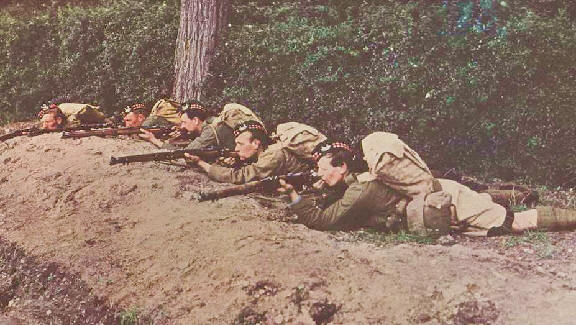
Scottish Regulars at the First Battle of the Marne
Click Here to Visit War in a Different Light
|
 |
Shell Shock Exhibit at the National Library of Medicine, National Institute of Health
By Carol Clausen
|
I'm the curator of the current presentation on shell shock at the National Library of Medicine. It will run through the end of May. The exhibit grew out of my reading Pat Barker's wonderful novel,
Regeneration. The novel is a fictionalized account of Siegfried Sassoon and
W.H.R. Rivers, the RAMC psychiatrist who treated him for shell shock in
1916. The very sympathetic picture Barker drew of Rivers made me want to
learn more about him. I discovered a remarkable man who made his mark in
neurology and anthropology before turning to psychiatry during the War. This
wartime experience changed a shy and reclusive scholar into a warm and
empathetic therapist who inspired gratitude and love from his patients..
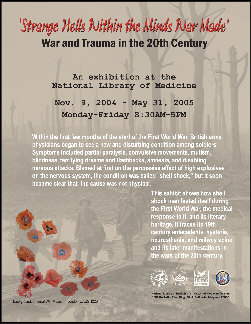
Event Poster |
Interest in Rivers led me to a general interest in shell shock, a
fascinating subject because of its almost indefinable nature. It has
puzzled physians since they first investigated it in the mid-nineteenth
century to the present day. Was its cause physical or purely psychological?
Did some existing condition or personality type predispose one? Was it an
illness at all or a normal, if extreme, coping mechanism when faced with an
unbearable experience? What could account for the myriad symptoms, both
physical and psychological? These questions provoked and disturbed the
military and government authorities of all the European combatants of the
Great War. They are still largely unanswered.
Following the elusive course of shell shock and its manifestation both
before the Great War and since led me to a general interest in the
soldiers's experience of the War and the conditions that had such terrible
personal consequences. Two exhibit cases suggest these experiences with
depictions of no man's land and a trench. Photographs from the Imperial War
Museum, enlarged to life-size, form the backgrounds and appropriate
artifacts are scattered on the ground - battlefield debris for no man's land
and mess kit, canteen, trench lantern, etc. for the trench. This second case
reflected my interest in the literary heritage of the War, with the stories
of Siegfried Sassoon, Wilfred Owen, and Ivor Gurney, all of whom were
affected in some manner by shell shock. (The title of the exhibit is taken
from a Gurney poem.) It is meant to suggest the presence of a
literary-minded British officer. So, falling out of a knapsack are my own
copies of Henri Barbusse's Under Fire, published in 1917, one of the first
books to describe the full horrors of the War and an influence on the
British anti-war movement, and Homer's Odyssey, in Greek, of course (Oxford
University Press, 1893), a story that has been interpreted (see Jonathan
Shay's Odysseus In America: Combat Trauma and the Trials of Homecoming), as
a depiction of the traumatized soldier unable to find his way back to a
normal life. For the entire exhibit is meant to be a commentary on the
long-lasting and tragic destructiveness of war.
The National Libary of Medicine is part of the National Institute of Health and is located at 8600 Rockville Pike, Bethesda, MD 20894. The Libary is open to the public weekdays, 8:30-5:00.
|
Restoration of the Lion Monument at St. Mihiel
By Christina Holstein
As mentioned in an earlier edition of the St. Mihiel Trip Wire, the village of Valbois
near Apremont wishes to restore the Bavarian lion monument, which stands by the
side of the road between St. Mihiel and Apremont, France.
Expert evaluation shows that the lion is too damaged to be restored but must be
replaced at an estimated cost of 15 000 euros. As the village of Valbois is too
small to pay for the restoration, the mayor is appealing for donations.
Donations may be made by cheque, made out to the 'Tresorerie de Saint-Mihiel' and
sent to the following address: Tresorerie de Saint-Mihiel, 2, ave. de la Libération,
55300 Saint-Mihiel, France.
It would be helpful to add a note to the effect that the donation is intended for
the renovation of the lion monument. The following words may be used in French 'Ce
don est destiné ŕ la rénovation du "Lion"'. Donors who prefer to make a donation by bank transfer should contact Christina Holstein holstein@vo.lu for further details.
The mayor of Valbois has promised to keep each donor informed of the progress of
the fund and the work carried out.
|
| The following are thanked for their contributions to this issue of the Trip Wire: Christina Holstein, Carol Clausen, Joaquin Espinoza, Len Shurtleff, Tony Langley, Andy Melomet, Len Shurtleff, Sebastian Wittler and Susan Neeson. Until next month, your editor, Mike Hanlon. |
|








